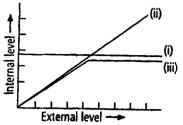The evolution of the animal immune system was probably driven by:
(1) Herbivores pushing the animals toward extinction
(2) The selective pressures of parasitic and disease organisms
(3) Competition between the animals and their habitats
(4) Symbiosis between the animals and their predators
Which of the following is not entirely true fact?
1. Competition occurs when closely related species compete for the same resources that are limiting
2. Totally unrelated species could compete for the same resource
3. Resources need not be limiting for competition to occur. In interference competition, the feeding efficiency of one species might be reduced due to the interference and inhibitory presence of the other species, even if resources are abundant.
4. A complex interplay of interspecific interactions and environmental variability characterizes community structure
Connell's elegant field experiments are related to:
1. Paramecium
2. Barnacles
3. Viruses
4. Protozoans
Select the false one:
1. The niche of a population is the set of conditions and resources it uses
2. Competitive exclusion principle was first described by Gause, for species of Paramecium
3. If a new predator is introduced to an area the prey species is likely to decrease and possibly become extinct
4. None of the above
A bird introduced from another country became a serious pest due to:
1. Better adaptation to new area
2. More sexual reproduction
3. Better nesting habitats
4. Absence of natural competition
Through resource partitioning:
1. Two species can compete for the same prey
2. Slight variation in niche allow closely related species to co-exist in the same habitat
3. Competitive exclusion results in the success of the superior species
4. Two species undergo character displacement that allows them to compete
The figure given below is a diagrammatic representation of response of organisms to abiotic factors. What do (i), (ii) and (iii) represent respectively?
| (i) | (ii) | (iii) | |
| (1) | Conformer | Regulator | Partial regulator |
| (2) | Regulator | Partial | Conformer regulator |
| (3) | Partial | Regulator | Conformer regulator |
| (4) | Regulator | Conformer | Partial regulator |
When the value of 'r' is significantly low as compared to another species, it is better known by:
(1) Competition exclusion
(2) Interference competition
(3) Resource partition
(4) Competitive release
The four levels of biological organization to which Ecology is basically concerned are:
1. Macromolecules-tissues-populations-biome
2. Macromolecules-organisms-population-biome
3. Tissues-organs-community-biome
4. Organisms-Populations-Community-Biome
Physiological ecology
1. works at the organismic level
2. Tries to understand the adaptation with respect to survival only
3. Tries to understand the adaptation with respect to reproduction only
4. None of these







